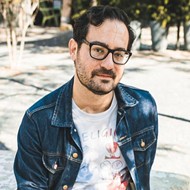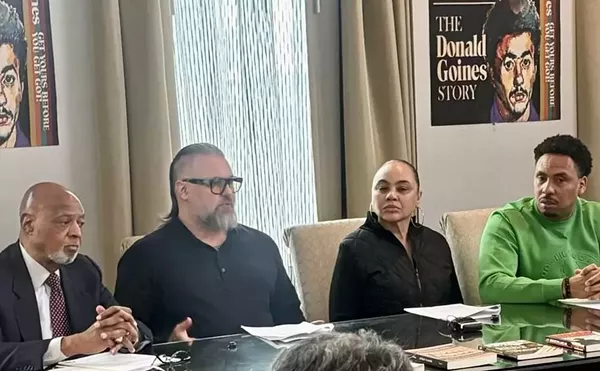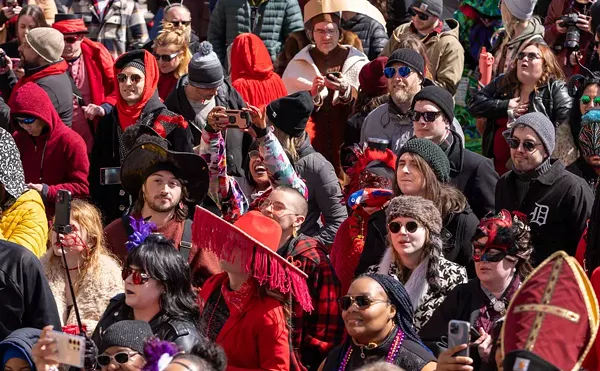Ed Fella has it pretty easy now. The Detroit native recently retired from a 25-year stint teaching at CalArts university outside of Los Angeles, but he still gets to keep a small studio on the campus. "Like an honorary professor emeritus," he explains by phone. "I'm the only one [here] who's ever had this. Not that anyone else has really wanted it. When they retire, they just want to get up, go someplace."
It's a world away from his younger days, where he spent 30 years cutting his teeth as a commercial artist in Detroit's advertising business through the '50s, '60s, and '70s. But it was between agency gigs that Fella truly honed his skills, creating the experimental posters and flyers for various artist collectives for which he would become world-renowned as a great post-modern graphic designer.
"Nobody ever was in the office 9 to 5," he explains of the agency days. "It was more like 9 to 9. Or around the clock. There were no set hours. Some people liked working early in the morning. There were lots of all-nighters."
He worked for firms such as New Center Studios, Phoenix Studios, Skidmore Studios — "They were all along Congress Avenue, which was kind of Detroit's Madison Avenue at the time," he says — creating fairly tame collateral for the auto and healthcare industries. But on his own time, he was a member of artist collectives like the Detroit Focus gallery, the Detroit Artist Market, and others, where could really let loose and experiment.
Fella describes his graphic design at this time as more like artful poetry than utilitarian prose, breaking what is known in designer's terms as "the grid" and employing expressive hand-lettering. "With prose, you could read it fairly quickly and get meaning out of it," he says. "Poetry takes a little longer to read, but you still in the end get the meaning. The information was there, but it was harder to get it to.
"I demanded some time — but art demands the same thing," he says. "You don't just glance at a painting."
In that way, Fella was a sort of designer's designer, breaking the rules for great visual effect. "I said, you know, you guys get to show your performance work and your artwork, and as a graphic designer part of it is for me to get to show my experimental typographic work," he explains. And Fella's reputation among other designers grew as he switched from ad agency to ad agency, gaining respect in the studios as the "king of zing."
Yet not everyone in the scene was on board with his posters, which he describes as on the "edge of legibility."
"They were very controversial. A lot of the artists hated the things, but other artists welcomed them," he says of his deconstructive typography. "It was just so ... nobody ever saw anything like that before, and they didn't know what to make of it."
Fella ultimately retained creative freedom, though, because he did the posters for free. "I said, 'I can make a poster for you, but it has to be for you, as well as me,'" he explains. "That was the slogan I had — 'You as well as me.' You allow me to do this and play around a bit with my typography and the conventions of a poster, and I'll make you that poster."
Fella says what he did was not unlike experimental Dada typography or punk-rock flyers. "It's always been part of the arts scene in some way or another," he says. "People are used to promotion being done in a very functional, conventional way, and I admit, 99 percent of it should be done that way. But only in this particular case — because it was an arts organization — it had a different demographic.
"You're not making that punk flyer to try and get middle-aged suburbanites to come to your punk concert," he says. "The best example of that is the psychedelic posters in the '60s in San Francisco. They were meant to be only for those people who were cool enough to go to rock concerts. They didn't even want anyone else to even come to them. So they made the posters so they would turn off everyone else and turn on only those people who got it."
Fella's parents, both immigrants from Europe, encouraged his artistic inclinations at an early age. Fella says his father used to take him to painting classes that were held in Rivera Court at the Detroit Institute of Arts — "Like having an art class in the Sistine Chapel!" he says. He later attended and graduated from Detroit's Cass Technical High School, where he studied commercial art.
After 30 years of working in advertising, Fella went back to school in the '80s, getting his undergraduate degree at the College for Creative Studies before heading to Cranbrook Academy of Art for his master's. It was after this time that he created OutWest, a digitized version of a quirky typeface that he hand-designed that became a popular early desktop computer font.
A body of Fella's work, spanning from his agency days through his experimental posters and beyond, will get the retrospective treatment at a show at the College for Creative Studies. Looking at his work, Fella admits that his posters don't look as radical today as they did then. "We've had 25 years of this stuff," he says. "The stuff I do, the current generation isn't even interested in. They're on to something altogether different. Just the opposite — a kind of minimalism, or modernism.
"That's where I differ from the modernist designers, because they figure that their design was for all time," Fella says. "A post-modernist designer like me, their design was for its time."
Now, Fella's website proclaims his latest job title is "exit-level designer."
"You know, when you start as a designer, you call yourself an entry-level designer," he explains. "For me, 'exit-level' meant that I would no longer compete with the current generation, but I would still be part of it."
He once again invokes his native Detroit, comparing his philosophy to union leader Walter Reuther. "After 30 years, I wanted to turn the work over to the next generation," he says. "It's that idea of the '30 and out,' so the next worker could have a job. I figured for 30 years I did really well. Now I'm an exit-level educator."
Ed Fella: History, Commercial Art, Art, and the American Vernacular has an opening reception from 6 p.m. to 8 p.m. on Friday, Nov. 7 at the College for Creative Studies Center Galleries; 301 Frederick Douglass Ave., Detroit; 313-664-7800; collegeforcreativestudies.edu. A gallery talk is scheduled for 11:30 a.m. on Tuesday, Nov. 11. The show runs through Dec. 13.







